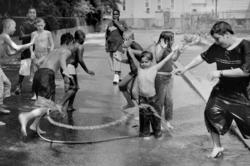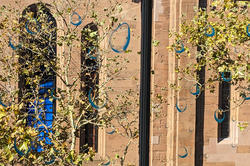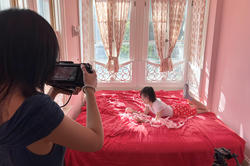Documentary photographer John Willis leads a fall studio built on trust, respect and the importance of community.
Apparel Design Studio Challenges RISD Students to Embody an Alter Ego
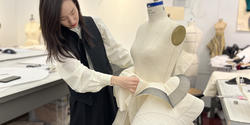
“We think it’s really important for students to explore ideas about who they are as artists and their points of view in fashion,” says Apparel Design Department Head Gwen van den Eijnde. “As we stretch this topic of identity, they start to invent their own aesthetic vocabularies.”
Van den Eijnde is coteaching a yearlong sophomore studio called Identities with faculty member Jackey Robinson MArch 22. Throughout the fall, students will create alter egos for themselves and embody them in end-of-semester performances. In the spring, students will shift their focus to designing alternative personalities for their classmates.
Students first played with the concept of identity during a three-hour trip to popular regional thrift store Savers. They began by recreating the style, posture and emotional language captured in a fashion photograph of their choice before setting out to express their alter egos through clothing.
Later, students learned about the social, economic and political history of various fashions and how apparel can represent identity. “Identities or alter egos can be rooted in joy, expression and trauma,” explains Robinson, who incorporates his knowledge of ballroom culture into the curriculum. Throughout the course, both Robinson and van den Eijnde stress the importance of “comprehending how identities can dictate positioning in society.”
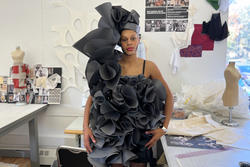
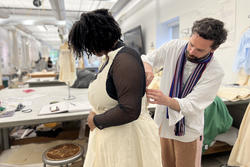
“We want students to have the space to develop their own sensibilities and really bring themselves into the course.”
At an informal, mid-semester critique, van den Eijnde and Robinson offer feedback on student projects. A garment made by Azaria Smallwood 26 AP features large swirls made from black construction paper that fully engulf her body. “This is an exploratory moment for me,” she says. “Through this piece I explored my alter ego by shifting the manner in which I generally interact with society, shielding my body within this voluminous form.” For her final performance, she is considering the idea of having classmates trim the edges of the swirls to expose more of her body using sleek silver scissors.
Maya Muravlev 26 AP is diving into an exploration of ruffled collars and how they have historically framed elements of the wearer’s identity, such as class and gender. “I like what you said about things unraveling,” says Robinson. “I would like to see different finishes for each collar, different materials. Think about the relationships between all of the collars and the shirt.”
Also looking back in time is Liam Rounds 26 AP, whose work centers around the AIDS epidemic. “I started by thinking about Victorian Gothic mourning clothes, but it turned into an homage to queer artists from the 1980s and other people who died young of AIDS.” Rounds’ preliminary design features a corset with a hoop-framed skirt, black trash bags and faux organs to represent how AIDS affects specific internal systems in the body. “You’re transforming the trash bags really well,” Robinson says. “You can even play with bags of different thickness.”
Xinyu (Jaclyn) Zhang 26 AP is also working with the color black as she explores the concept of security and how wearing black shields the body and creates a sense of mystery. After finding boning too inflexible for her piece, Zhang watched YouTube videos to learn how to work with horse hair to help hold the curved, playful shape of the garments. “This is great experimentation,” says van den Eijnde. “It’s so delicate, and there’s so much movement. It will be a very sculptural piece.”
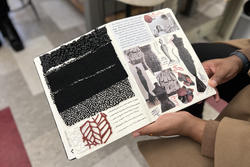
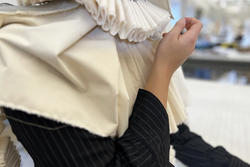
Paige Sias 26 AP is exploring Black femininity, designing a long, sleeveless dress inspired by 1950s-era fashion. “Historically, Black women were either outside the feminine or hyper-sexualized,” says Sias. “I’m also exploring different kinds of love: romantic love, motherly love and self-love.”
Towards the end of the semester, Robinson will lead the course. “Gwen does a lot of the identity work in the beginning, and then I come in to teach the students about the performance aspect,” says Robinson. “That’s when they’ll be trying on their alter egos and learning how to embody them in preparation for the final crit.”
Van den Eijnde is excited about the progression of the course, which was first developed in 2018. “We end up with really personal work,” he says. “In the fall, it’s all about the self and self-fashioning. The spring will be about community and inviting others to step into your vision. We want students to have the space to develop their own sensibilities and really bring themselves into the course.”
Isabel Roberts / top image: Jaclyn Zhang works with muslin
November 13, 2023
